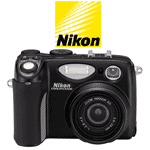VR Panoramas > Equipment
Cameras
 |
A camera is obviously the most vital piece of equipment if you’re taking photographic panoramas, there are some things you’ll need to be aware of when choosing a camera for the job. First of all, a choice must be made between digital or film-based photography. We won’t discuss that in depth here, but an excellent comparison table can be found at http://www.panoguide.com/technique/gear.html. Also, in depth, and up-to-date, comparisons of digital cameras can be found at sites such as http://www.dpreview.com/. |
Assuming you decide on using a digital camera, the following features will make your life much easier:
- Wide Angle Lens – a wide-angle lens means you can capture more of the landscape in a single photograph. This means (a) less photographs need to be taken and (b), the panorama will have more ‘height’ – that is it won’t appear as much as a ‘slit’ of an image. Again, more can be found about this at http://www.panoguide.com/technique/gear.html.
- Memory. Bearing in mind you’ll need to take upwards of 18 photos per panorama, a camera with a ‘microdrive’ (a mini hard-drive) or a memory card with a large capacity is in order!
- Exposure Lock. During the process of taking the images necessary for a panorama you are likely to take them in varying light conditions. ‘Auto-exposure’ can cause problems in these cases, as it will ‘lighten’ or ‘darken’ your image as it sees fit. Exposure lock will ‘lock’ the exposure setting to that of the first image, meaning your photos will turn out of a equalised darkness level (this will be vital when trying to “stitch” them).